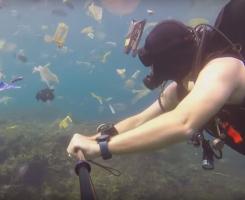 Manta Point is a popular dive spot off the southernmost shore of Nusa Penida Island, near Bali, Indonesia. Divers are attracted by the large number of manta rays which congregate there. On March 3rd, a British diver, Rich Horner, found far more than mantas at Manta Point. He found himself swimming in a sea of plastic garbage. His video of swimming through the mass of debris and trash has gone viral. It is disturbing to watch. The video is the bad news. The good news or perhaps the less bad news is that the video doesn’t tell the whole story.
Manta Point is a popular dive spot off the southernmost shore of Nusa Penida Island, near Bali, Indonesia. Divers are attracted by the large number of manta rays which congregate there. On March 3rd, a British diver, Rich Horner, found far more than mantas at Manta Point. He found himself swimming in a sea of plastic garbage. His video of swimming through the mass of debris and trash has gone viral. It is disturbing to watch. The video is the bad news. The good news or perhaps the less bad news is that the video doesn’t tell the whole story.
The story is a bit more complicated than it may first appear. After the video spread widely, the Indonesian Ministry of Maritime Affairs sent a team to survey the waters off Manta Point. Divers surveyed the waters on March, 8th, 9th, and 10th and found them free from trash. They also interviewed Rich Horner, who took the viral video, who explained that normally there was little or trash at Manta Point but that the day he took the video was exceptionally bad. So what is going on?
Horner said the level of plastic at that site varied throughout the year, and there was no plastic visible during the dry season but random clouds and slicks appear during the wet season. He said this trash in the footage had cleared by the next day.
Where is the trash going? At least some is being consumed by the manta rays. Even intermittent clouds of garbage can still do serious damage. ABC News Australia reports:
A new study by researchers from Australia, Italy and the US have found tiny plastic particles are a particular threat to “filter-feeding” animals like the manta rays near Bali, which can swallow up to 90 pieces every hour.
Murdoch University lead researcher Elitza Germanov said microplastics — particles smaller than five millimetres long — contain toxic chemicals that, if ingested, could alter biological processes in the animals, such as growth, development, and reproduction.
“We are still trying to understand the magnitude of the issue,” Ms. Germanov said.
Ms. Germanov, who is in the final stages of a Ph.D. project through Murdoch University, is focusing on plastic pollution in manta ray feeding grounds around the coastline of Nusa Penida and Komodo National Park in Indonesia.
“Plastics are definitely on the menu here,” she said.
There is hope that greater public awareness of the global problem of plastic trash being dumped into the oceans, of the sort provided by Mr. Horner’s video, will result in government action. In the case of Bali, tourism is both the problem and also a potential solution. On one hand, international tourism to the island rose to 3.4 million in 2017. The tourists generate vast amounts of waste and trash. On the other hand, tourists are demanding clean beaches and waters before they spend their vacation dollars. Divers will not pay outfitters to taken them to seas of debris. With luck, Bali will refocus its efforts on keeping the trash out of the waters.
So much plastic!’: British diver films deluge of waste off Bali
Plastic debris at Manta Point, Bali?
Thanks to Alan Rice for contributing to this post.

At 2:16 pm Eastern Time, I sent you this video.
*’We use plastic without a
thought’*
https://news.sky.com/
video/we-use-plastic-
without-a-
thought-11398053
Please see – https://www.youtube.com/watch?v=qpL3pXUaans
“…random clouds and slicks appear during the wet season.:
Here where we sail it’s the case that heavy rains or snow melt mean that navigation will include keeping an extra sharp eye out for floating wood in all its forms. River banks, snag banks etc. get flushed. I can picture the same thing happening where rivers pass through human habitation and a libertarian utopia or whatever means there’s no formal garbage disposal.
So the good news would seem to be that this problem could end as soon as we accept that we need adult supervision and are forced to clean up after ourselves.